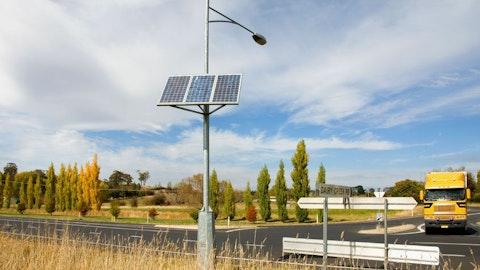Bob Blue: Yes. We communicate regularly with them, with our suppliers and if you look at the deck that we posted on the website on offshore wind, we walk through each one of them and the status of the contract with each of them and you can see they’re all performing and they’re all performing on time. Now I know that Siemens in particular is one that’s been in the news recently and there are turban provider. I communicate regularly with the CEO Siemens Gamesa Renewable Energy and I most recently heard from him after that news on some of the challenges that they’re facing mostly with their onshore business and sort of project potential that they have but they need to be able to put guarantees on those. So they are growth opportunities but that’s causing them some challenges that have been in the news.
So he assured me they’re committed to their contractual obligations and he said nothing will change the close and successful partnership we have from their side. So we’re very focused on this. We communicate regularly with all of those providers and as we outlined earlier and as you can see in the deck, those projects are going very well. They’re all performing. They’re all on time.
Steve Fleishman: Okay. One last quick one for Steve, just the simple one. The slide that talked about the 290 for ’23 and don’t just use a normal utility growth rate to ’25 and you go through those factors. Looks like pretty much almost all of them are positive factors. So, my interpretation of that is it should be better than that. I just want to make sure that that’s correct.
Steven Ridge: Well, we’re not giving guidance. So, I’ll start with that. I think we provided this list to try and be comprehensive and holistic, so that we’re not suspected of trying to cherry pick or give half guidance. We talked a lot internally in advance of this call about staying true to what we’ve done thus far, which has been disciplined about not providing partial guidance until the review is complete and this is in the spirit of that. Now, I would just say on individual items, some of these are certainly tailwinds. Higher rates, of course, I probably wouldn’t describe that as a tailwind, but we talk about the in-the-money portfolio of rates. So, I don’t want to get into a box given that we’re not giving guidance on any of these particular items, except we felt it was important to highlight the various inputs that we have not disclosed that we think will be important to analyzing accurately what our 2025 earnings will be.
Steve Fleishman: Great. Thank you very much. Appreciate it.
Operator: And we have our next question from Jeremy Tonet with JPMorgan.
Jeremy Tonet: Appreciate the commentary just laid out there with regards to how you’re talking about the review, but just wanted to go to the dividend, if I could, and just wanted to see if the dividend policy remains intact, even if for some reason you keep all of wind. Is there any scenario where, keeping the dividend at these levels just wouldn’t make sense?
Bob Blue: We’re committed to the dividend, Jeremy. As we said, we’re 100% committed to the dividend. Trying to talk about scenarios that people could imagine, I don’t think is terribly productive. We’ve been committed to the dividend since the beginning. We haven’t wavered in that. We’re not wavering on it today.
Jeremy Tonet: Got it. That’s very helpful. I’m going to leave it there. Thank you very much.
Operator: And we have our next question from Carly Davenport with Goldman Sachs.
Carly Davenport: Hey, good morning. Thanks for taking the questions and for all the color thus far. Maybe just one quick one on the business review. I guess, can you just help us frame the risk around the timeline here? Are there any factors in particular that you’re watching that could potentially push that beyond the, late ’23 to early 2024 timeline that you’ve lined out?
Bob Blue: No. We, I think, laid it out pretty clearly. We’re in the last stage here on evaluating an offshore wind equity partner. But no, there’s nothing else out there.




